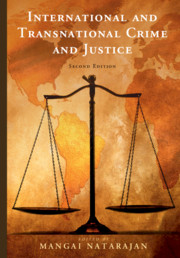Book contents
- International and Transnational Crime and Justice
- International and Transnational Crime and Justice
- Copyright page
- Contents
- Figures and Tables
- Preface
- About the Editor
- Notes on Contributors
- Introduction
- PART I OVERVIEW: TRANSNATIONAL CRIME
- PART II OVERVIEW: INTERNATIONAL CRIME
- PART IIA Core International Crimes (As Defined by the Rome Statute, 1998)
- PART IIB International Crime and Justice for Women and Children
- PART IIC International Justice
- 65 The Role of the United Nations
- 66 Treaties and International Law
- 67 The International Criminal Court
- 68 The ICC and the Darfur Investigation Progress and Challenges
- 69 Victims’ Rights in the International Criminal Court
- 70 International Criminal Tribunals and Hybrid Courts
- 71 Global and Regional Human Rights Commissions
- 72 The Truth and Reconciliation Commission in South Africa in Perspective Origins and Achievements
- 73 The Guatemalan Truth Commission Genocide Through the Lens of Transitional Justice
- 74 Nongovernmental Organizations and International Criminal Justice
- 75 Transforming Restorative Justice for Transitional Settings
- PART III OVERVIEW: INTERNATIONAL AND TRANSNATIONAL CRIME RESEARCH
- World Map
- Index
- References
72 - The Truth and Reconciliation Commission in South Africa in Perspective Origins and Achievements
from PART IIC - International Justice
Published online by Cambridge University Press: 20 June 2019
- International and Transnational Crime and Justice
- International and Transnational Crime and Justice
- Copyright page
- Contents
- Figures and Tables
- Preface
- About the Editor
- Notes on Contributors
- Introduction
- PART I OVERVIEW: TRANSNATIONAL CRIME
- PART II OVERVIEW: INTERNATIONAL CRIME
- PART IIA Core International Crimes (As Defined by the Rome Statute, 1998)
- PART IIB International Crime and Justice for Women and Children
- PART IIC International Justice
- 65 The Role of the United Nations
- 66 Treaties and International Law
- 67 The International Criminal Court
- 68 The ICC and the Darfur Investigation Progress and Challenges
- 69 Victims’ Rights in the International Criminal Court
- 70 International Criminal Tribunals and Hybrid Courts
- 71 Global and Regional Human Rights Commissions
- 72 The Truth and Reconciliation Commission in South Africa in Perspective Origins and Achievements
- 73 The Guatemalan Truth Commission Genocide Through the Lens of Transitional Justice
- 74 Nongovernmental Organizations and International Criminal Justice
- 75 Transforming Restorative Justice for Transitional Settings
- PART III OVERVIEW: INTERNATIONAL AND TRANSNATIONAL CRIME RESEARCH
- World Map
- Index
- References
- Type
- Chapter
- Information
- International and Transnational Crime and Justice , pp. 439 - 444Publisher: Cambridge University PressPrint publication year: 2019
References
REFERENCES
WEBSITES
Centre for the Study of Violence and Reconciliation. www.csvr.org.za.
International Centre for Transitional Justice. www.ictj.org.
International Institute for Democracy and Electoral Assistance. www.idea.int.
Program on Negotiation, Harvard Law School, and European Centre for Common Ground. www.truthcommission.org.
Truth and Reconciliation Commission. www.doj.gov.za/trc.
United States Institute of Peace. www.usip.org/library/truth.html.

